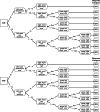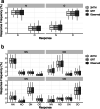The simultaneous recognition of multiple words: A process analysis
- PMID: 33834382
- PMCID: PMC8081710
- DOI: 10.3758/s13421-020-01082-w
The simultaneous recognition of multiple words: A process analysis
Abstract
In everyday life, recognition decisions often have to be made for multiple objects simultaneously. In contrast, research on recognition memory has predominantly relied on single-item recognition paradigms. We present a first systematic investigation into the cognitive processes that differ between single-word and paired-word tests of recognition memory. In a single-word test, participants categorize previously presented words and new words as having been studied before (old) or not (new). In a paired-word test, however, the test words are randomly paired, and participants provide joint old-new categorizations of both words for each pair. Across two experiments (N = 170), we found better memory performance for words tested singly rather than in pairs and, more importantly, dependencies between the two single-word decisions implied by the paired-word test. We extended two popular model classes of single-item recognition to paired-word recognition, a discrete-state model and a continuous model. Both models attribute performance differences between single-word and paired-word recognition to differences in memory-evidence strength. Discrete-state models account for the dependencies in paired-word decisions in terms of dependencies in guessing. In contrast, continuous models map the dependencies on mnemonic (Experiment 1 & 2) as well as on decisional processes (Experiment 2). However, in both experiments, model comparison favored the discrete-state model, indicating that memory decisions for word pairs seem to be mediated by discrete states. Our work suggests that individuals tackle multiple-item recognition fundamentally differently from single-item recognition, and it provides both a behavioral and model-based paradigm for studying multiple-item recognition.
Keywords: Cognitive modeling; Continuous models; Discrete-state models; Recognition memory.
Figures





References
-
- Allen LR, Garton RF. The influence of word-knowledge on the word-frequency effect in recognition memory. Psychonomic Science. 1968;10(12):401–402. doi: 10.3758/BF03331581. - DOI
-
- Ashby FG, Perrin NA. Toward a unified theory of similarity and recognition. Psychological Review. 1988;95(1):124–150. doi: 10.1037/0033-295X.95.1.124. - DOI
-
- Ashby, F. G., & Soto, F. A. (2015). Multidimensional signal detection theory. In J. R. Busemeyer, Z. Wang, J. T. Townsend, & A. Eidels (Eds.) The Oxford handbook of computational and mathematical psychology. Oxford library of psychology. New York: Oxford University Press, pp. 13–34.
Publication types
MeSH terms
LinkOut - more resources
Full Text Sources
Other Literature Sources

